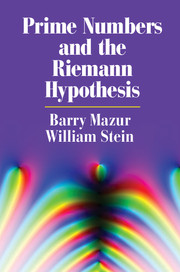‘This is an extraordinary book, really one of a kind. Written by two supreme experts, but aimed at the level of an undergraduate or curious amateur, it emphasizes the really powerful ideas, with the bare minimum of math notation and the maximum number of elegant and suggestive visuals. The authors explain why this legendary problem is so beautiful, why it is difficult, and why you should care.'
Will Hearst - Hearst Corporation
‘This book is a soaring ride, starting from the simplest ideas and ending with one of the deepest unsolved problems of mathematics. Unlike in many popular math books puffed up with anecdotal material, the authors here treat the reader as seriously interested in prime numbers and build up the real math in four stages with compelling graphical demonstrations revealing in deeper and deeper ways the hidden music of the primes. If you have ever wondered why so many mathematicians are obsessed with primes, here's the real deal.'
David Mumford - Brown University, Rhode Island
'This is a delightful little book, not quite like anything else that I am aware of … a splendid piece of work, informative and valuable. Undergraduate mathematics majors, and the faculty who teach them, should derive considerable benefit from looking at it.'
Mark Hunacek
Source: MAA Reviews
'This book is divided into four parts, and succeeds beautifully in giving both an overview for the general audience and a sense of the details needed to understand how quickly the number of primes grows. This is accomplished through a very clear exposition and numerous illuminating pictures.'
Steven Joel Miller
Source: MathSciNet
'Where popularizers of mathematics usually succumb either to a journalist's penchant for ‘man bites dog’ irony and spectacle or a schoolteacher's iron will to simplify away the terror, one might call the distinctive approach here ‘take a lay reader to work’. Computers now provide mathematicians a laboratory, and the authors exploit this modern power to exhibit graphics, making the key equivalence a luminous phenomenon of experimental mathematics … for its clarity and the importance of its topic, this book deserves the same classic status as A Brief History of Time (CH, Jul'88). Summing Up: Essential. All readers.'
D. V. Feldman
Source: CHOICE
'Prime Numbers and the Riemann Hypothesis is an agile, unusual book written over a decade, one week per year; it can be considered a sort of collaborative work, in that each version was put online with the purpose of getting feedback.'
Massimo Nespolo
Source: Acta Crystallographica Section A: Foundations and Advances
'… a great gift for a curious student. Using the graphical methods found in calculus reform texts, this beautiful little book allows a patient reader with a good grasp of first-year calculus to explore the most famous unsolved problem in mathematics, the so-called Riemann Hypothesis, and to understand why it points to as yet undiscovered regularities in the distribution of prime numbers.'
Donal O’Shea
Source: The Herald Tribune
'The book under review succeeds handsomely in making the case for the Riemann Hypothesis to a wide audience … Beginning with the definition of prime numbers, the authors weave their way through concrete and picturesque presentations of elementary techniques and descriptions of unsolved problems connected with the primes. They provide many insightful footnotes, concrete and illuminating figures, pointers to arXiv pages for added information, and a rich set of endnotes that contain further descriptions and details with varying levels of sophistication. After 23 short sections (a few pages each) they have arrived at a formulation of the Riemann Hypothesis in terms of counting primes up to a given size. By this point in their masterful and compelling presentation, the Hypothesis appears to be completely natural and inevitable … I have no doubt that many newcomers to the subject who have read to the end of the book will be eager to learn more and will be drawn into this fertile playground.'
Peter Sarnak
Source: Bulletin of the AMS
'I really recommend this book if you want to get a feeling for the Riemann hypothesis without sinking into technicalities.'
John Baez
Source: The n-Category Café (http://golem.ph.utexas.edu/category)



